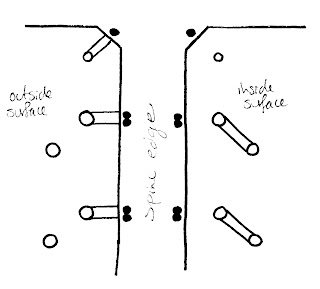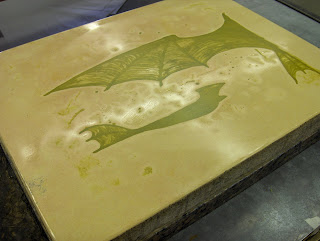I was rummaging around in my files, looking for pictures I can post on my deviantART page (go, look, I added more stuff today). Anyway, I found the essay I wrote for Intermediate Book Arts last fall, and though it would be fun to post it here, diagrams and all. I'll forgive you non book-geeks if you don't want to read it all . . .
 Gothic Medieval Bookbinding Project
Gothic Medieval Bookbinding ProjectThe prospect of choosing a book arts final project was at first daunting. With so many possibilities, all of which I want to learn about, how could I choose just one? In the end, I decided on a time period that we hadn’t learned much about in class, but which was an important one for the development of book structure: the medieval period.
Even that decision didn’t narrow the possibilities that much, but realizing that I would not be able to acquire any parchment for an accurate reproduction of an early medieval book, I settled on Gothic bookbinding, when paper would have been more and more common in book production.
PaperPaper was eventually the dominant material for textblocks in Gothic bindings, but was originally thought to be weaker than parchment. Paper was therefore often combined with parchment in a variety of ways, such as the addition of an inner or outer parchment bifolium to each paper section or to the end sections, or a narrow parchment guard to the inner fold of each section (Szirmai 176, Shailor 11-12).
Because of the expense of parchment (and also because I would have had to order it well ahead of time), I chose to use paper for this project. I found a very nice Italian mould-made paper made of cotton with wool fibres. It is quite a thick paper, and thus perhaps not ideal for a tight-backed Gothic binding, but I liked the feel of it.
There are a wide variety of possible endleaves for a Gothic binding – Szirmai provides diagrams of 19 – most of which combine paper and parchment. As mentioned, I did not have access to parchment, and so I stuck with the same paper as the bookblock. The style of endpaper I used is one not illustrated in the Gothic bindings chapter of Szirmai's book (it is, however, shown in the Romanesque chapter, page 147), but which J. Landry mentioned as fairly common in English medieval bindings (pers comm.). It consists of a single bifolium with the outermost leaf cut of short to serve as a waste leaf. Both the stub of the waste leaf and the second leaf would be pasted to the board.
SewingThe holes for sewing a Gothic book could be either pierced or cut (Szirmai 176) – I chose to pierce them using a template to make sure I had them spaced and lined up properly.
According the J.A. Szirmai, Gothic books could have anywhere from two to nine sewing supports, with three to six being the most common (180). Because my book is small, I decided on three supports plus a kettlestitch at each end. The three supports are evenly spaced, as the optical illusion that necessitates a larger space between the bottom two supports on a raised-cord binding was either unknown, ignored, or of no concern at the time. Even as late as the 16th century it was common for books to be placed flat on a horizontal shelf, and when they were shelved vertically, it was as often as not with the fore-edge out (Petroski, 118-9).
The most common sewing supports on Gothic bindings were double cords and split thongs (Szirmai 183, Shailor 56), and since I wanted raised cords showing on the spine, I went with double cords and chose linen over hemp for strength. I sewed with a straight stitch rather than herringbone, because I wanted to pack the sewing which would help stabilize the rounded shape of the spine and create wider opening arch when the book is opened (Szirmai 272). I did the packing of the sewing after the bookblock was sewn and chose to pack each cord separately rather than doing each pair of cords together. It is possible to create a decorative effect by emphasizing the separate cords in this way (Landry, pers comm.).

The thread I used was 12/3, fairly thick to compensate for the relative softness of the paper and the thick sections.
EndbandsI had originally approached this project wanting to investigate endbands that were sewn at the same time as the sections were sewn. I had read about this in a number of bookbinding books (for examples see Burdett 143 and Johnson 85) but had been unable to find out how they were done or to find any examples. As I researched endbands, I did eventually find diagrams of integral endbands (Cockerell 110, Young 112). Szirmai describes a number of examples of this type of endband, but mentions that it was almost unknown on earlier medieval bindings (203). Integral endbands became more common on Gothic bindings (but still only account for 4.3% of the Gothic endbands Szirmai studied), indicating that they are a later innovation and not the original method of making endbands, as many writers would have it. Landry's experience with English bindings also indicated that integral endbands are the exception, and may have come from very few (or even just one) workshops (Email).
Although I am still curious about integral endbands and the origin of the misconception about their antiquity, I finally chose to use primary wound endbands with a back bead – Szirmai's Type II (206) – sewn with the same thread as the rest of the book. The endbands were tied down through the centre of each section.
 Boards
BoardsThe most common woods for the boards of medieval books are oak and beech, with oak being almost the only wood used in England (Szirmai 217). The boards were usually quartersawn, partly because that was the usual way of making planks for a long time, and also because quartersawn wood is less likely to warp, which is an important consideration for book covers (Landry, pers comm.).
To make the book boards, I used oak and cut it with a Japanese saw to almost the final size, then planed down the edges. Szirmai illustrates sixteen different ways to shape the outer edges of Gothic book boards (219). I chose to gradually round, or cushion, the outer edges – the rounding at the spine provides for a smooth path for the cords to travel, and the gradual rounding feels nice in the hand on the other three edges. The inner spine edge of the board is more strongly rounded to help force the spine of the book into a rounded and somewhat backed shape (Landry, pers comm.), and the other three edges are beveled.

There are a number of ways of lacing the cords into the boards (Szirmai shows several on page 223). I used one of the more common ones, with the double cords of the sewing supports laced in from the outside and back out from the inside, and the single cords of the endbands simply laced in from the outside. A channel for the cords is cut from the spine edge to the first hole on the outside, and between the two holes on the inside of the boards.

Once the cords are pasted and laced into the boards, they are pegged in with dowelling (Shailor 57) while the cover is at a 45º angle to the bookblock. Then the dowels and cords are cut off flush with the boards and the covers are forced closed which creates the rounded and backed shape of the spine (Landry, pers comm.). Szirmai has presented evidence that at least some workshops used a hammer to round and back books (194), but I decided to follow the my teacher's experience and besides, I had backed with a hammer before, but had not yet tried backing by forcing the spine into shape with the boards.

Once the boards were on and closed, the book was measured for making a template from which to cut the leather, and then put in a finishing press to keep it closed while the leather was prepared.
CoveringLeather was the most common covering material in medieval bindings, with vegetable-tanned calf and alum-tawed pigskin becoming more prevalent on Gothic books (Szirmai 225). Since I hadn't had a chance to work with it before, except as sewing supports on a sewing sample book, I originally chose to use alum-tawed pigskin. It became apparent, however, that the leather I had chosen was not going to work.
Because the book has laced-in endbands, the leather needed to be cut to have more-or-less V-shaped cutouts on the top and bottom edges. The resulting central tab would fold over to create the headcaps and the area at the point of the V would be molded around the endband cords and board edges. I wanted to leave most of the wood exposed.
This kind of leather was stiffer than the vegetable-tanned leathers I had used before, and has a tendency to chip. Even with very sharp knives, I found paring the alum-tawed pigskin very difficult. In fact, after pasting and applying the leather to the spine, it was still quite stiff. Even after removing the leather, paring it some more and re-pasting, it was still quite difficult to get it to adhere to the spine and boards. PVA on the turn-ins helped it stay, but after a night in the press the covering was still too stiff to open the book properly.

It was apparent that the alum-tawed pigskin would have to be removed and another leather chosen. I moistened the leather and carefully peeled it off, then scraped off some PVA that had remained stuck to the boards. For my second try, I used calfskin, which we dyed brown. It was much easier to pare and mould around the endbands than the alum-tawed leather.
Once the leather covering was on, the book was placed back in the finishing press and tied up with string on each side of the raised bands as well as on each side of the kettlestitches. This was to help shape the bands as band nippers were unknown in medieval times (Landry, pers comm.). Tying up would also help adhere the leather to the spine.
The final step in making this Gothic medieval style book was to paste down the endpapers.
ReferencesBurdett, Eric.
The Craft of Bookbinding: A Practical Handbook. 1975. London: David & Charles, 1978.
Cockerell, Douglas.
Bookbinding, and The Care of Books: A Text-Book for Book-Binders and Librarians. (1953). Revised edition. London: Sir Isaac Pitman, 1962.
Johnson, Arthur W.
The Practical Guide to Craft Bookbinding. 1985. London: Thames and Hudson, 1990.
Landry, J. Personal communication, November and December, 2006.
-----. Email. November 30, 2006.
Petroski, Henry.
The Book on the Book Shelf. New York: Alfred A. Knopf, 1999.
Shailor, Barbara A.
The Medieval Book, Illustrated from the Beinecke Rare Book and Manuscript Library. Toronto, Buffalo and London: University of Toronto Press, 1991. Rpt
of The Medieval Book: Catalogue of an Exhibition at the Beinecke Rare Book & Manuscript Library, Yale University. New Haven: The Library, 1988.
Szirmai, J.A.
The Archaeology of Medieval Bookbinding. Aldershot, UK: Ashgate, 1999.
Young, Laura S.
Bookbinding & Conservation by Hand: A Working Guide. New York and London: R.R. Bowker Company, 1981.

























